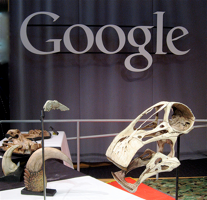 by http2007
by http2007
Acer suffers first-ever quarterly loss, predicts iPad ‘fever’ will recede
[Via AppleInsider]
Acer reported the first quarterly loss in company history on Wednesday, but the netbook maker’s chairman attempted to convince investors that consumer “fever” for tablets like the iPad will not last.
[More]
This is the elephant in the room – Apple has created a self-sustaining ecosystem that can not be attacked in just one area.
Losses are never a good thing, particularly when Apple is increasing market share. Perhaps this is another example of a company that is simply unable to compete in the ecological niche Apple has created?
The CEO of Acer seemed to keep talking about the iPad but I wonder just how much the Macbook Air has also eaten into earnings?
The number 1 maker of PCs – HP – just left the market. Now the number 2 is getting hit hard and will not be profitable this year.
Not a good sign.
Now Acer is floundering to find some sort of strategy using Android, just as HP floundered last year and bought the webOS for its own tablets. Could we see Acer calling it quits in a year?
These guys – HP, Samsung, Acer, Google, etc. – are all looking at the elephant that is the ecosystem Apple has created and only describing one part – like the leg or trunk – as though that was all that made the elephant.
“If we make a copy of the trunk, we will be an elephant too.” “Make that look more like its ear and we can win.”
Not going to beat the positive returns Apple gets from its ecosystem.
They still do not get it. And they seem to ignore the fact that now Apple’s huge money flow permits Apple to enhance its ecosystem.
Apple can now bring manufacturers into its ecosystem, paying them hard cash for first use of new technology, for discounted use of technologies and for new facilities that others simply can not do. This is now a win-win for them both as Apple gets the use of technologies that enhance their ecosystem providing them with even more revenue to use.
And the others are brought into the ecosystem where their business can be enhanced by Apple’s ecosystem. In fact, they can take greater risks because of the support from Apple’s money and actually create new technologies, thus more positive returns.
Positive returns that fall almost entirely to Apple’s bottom line, allowing them to increase the ecosystem. Every manufacturer must be clambering to get a deal with Apple. And if any one of them is unable to meet what Apple needs to support the ecosystem, Apple will find one that will.
So Apple’s positive ecosystem becomes even larger with positive feedbacks to enlarge and strengthen a system that others simply do not have.
According to Arthur’s model, it is now too late for anyone to beat Apple in this ecosystem. The only way to survive is to create a new niche.
The best example for this is Microsoft. At one time, they had the ecosystem and the positive returns that came from that. Apple could not compete and neither could anyone else.
Apple only succeeded by creating a niche that Microsoft simply could not compete with. And Microsoft is stupidly trying to compete in that niche as are all those other companies
It needs to create its own ecology. It has all the pieces.
Instead of trying to come up with a mobile version of Windows, in an ecology that will no longer bring the positive returns Microsoft used to get, MS should instead look to creating an ecology elsewhere.
Combine its hardware – Xbox/Kinect – with software – games – and bring in easy development tools to move these games to mobile devices – smartphone and tablets . MS would have an ecology that supports positive returns.
I wrote about this back in January. In the Xbox, Microsoft has the ability to create an ecosystem that Apple can not enter right now – gaming hardware that can become almost anything in the future; Kinect that provides a novel input device no one else has; and software control of a captured App economy.
If Microsoft became the best place to make money for game developers, if MS created an App economy for its Xbox/Kinect, if it then leveraged that hardware into supporting the software, MS would create a similar positive return ecology that Apple has created.
Then if it made things so that development for its Xbox allowed developers to easily move games to its smartphones/tablets, MS would have an ecology almost as powerful as Apple, able to produce positive returns.
No other company is in a position to do this right now, although Google may in a few years.
And it might survive then in a post-PC world.
Because a post-PC world is not simply one that is beyond a PC. It represents the epitome of a positive returns ecology, one where every aspect helps support every other one.
Companies need to create entire elephants rather than just copy the trunk.
 by
by 
 by
by  by
by  by
by  by
by  by
by